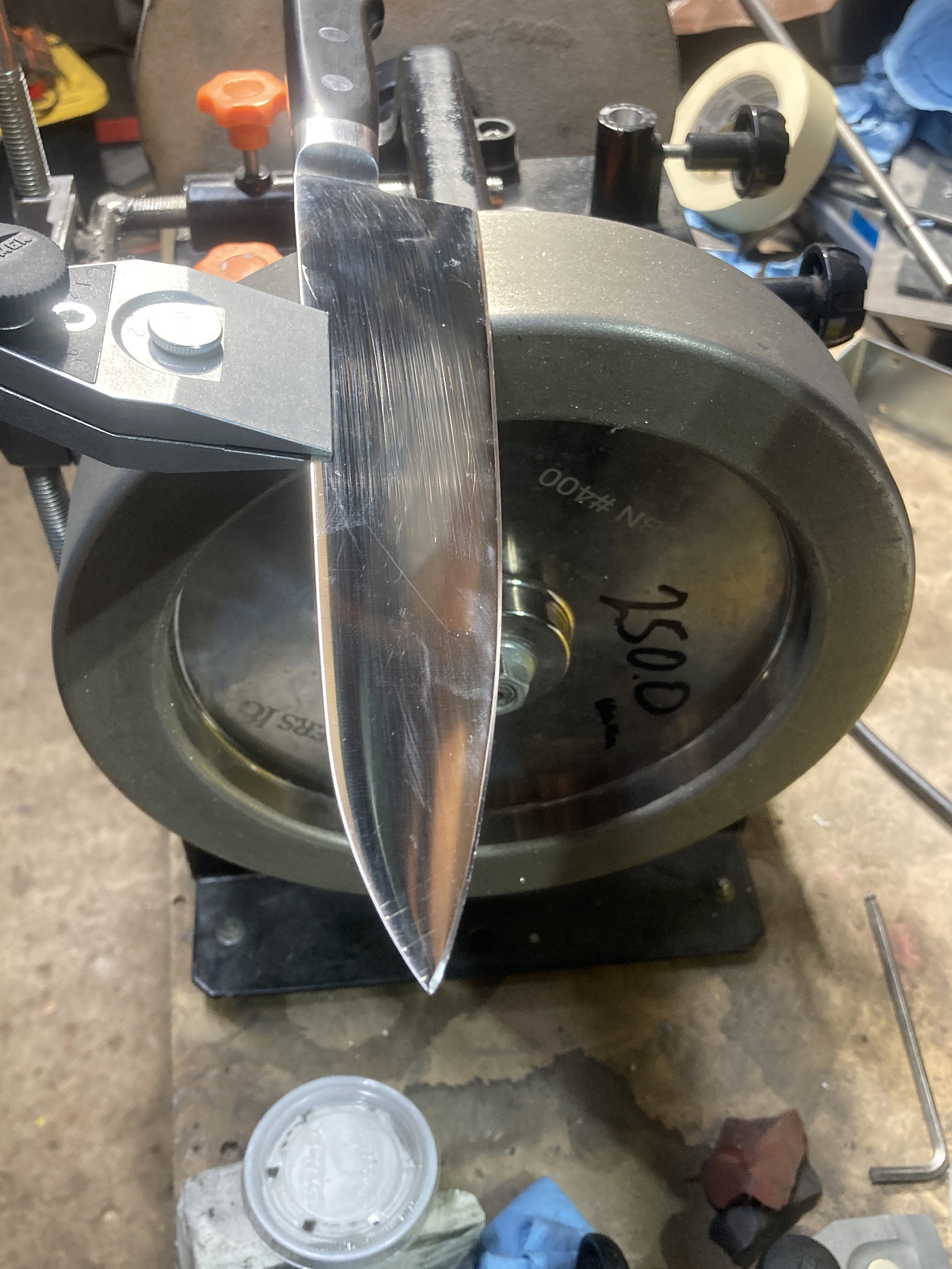tera forge precision sharpening overview
Wear Resistant Knives-High End Steels
I protect the blade from scratches at the site of clamping with a cloth tape.
Measure the existing edge angle with a laser protractor, if ordered to reproduce.
(my default is 13 degrees per side for high-end wear resistant knife steels.)
Clamp in a jig matching the blade thickness.
Set the grinding angle using KG_AU computer software.
Grind the bevel on a Silicon Carbide wheel SB grit 220, or a CBN wheel grit 160 or 200.
Continue on a 10” CBN wheel, grit 400 or 600.
Set the edge (apex) on a 10” CBN wheel, grit 1000.
A high volume of wear-resistant carbides in a blade requires a polishing progression of 10-micron - 5-micron - 2.5-micron diamonds. I use half-speed grinders with paper wheels. Slots in the wheels cool the blade like a fan as it is honed.
Polishing on the 10-micron diamonds is done at the edge angle, 2-4 passes alternating sides, till the burr is nearly gone.
Polishing on the 5-micron and 2.5-micron diamonds is done at a little less angle to spare the very apex, I set the PW supports at 0.1 degree less than the edge angle, and give the blade 2 passes each side on each wheel.
De-root the burr and remove wire edge on a 10" rock-hard felt wheel with 1-micron diamonds at a higher angle using a front vertical base.
I give the blade 3 slow passes alternating sides with little-to-no pressure.
Finish with controlled-angle honing on a 10” slotted paper wheel with a mix of 0.25 micron diamonds and Chromium Oxide at the exact edge angle.
Test.
The process for most stainless steels and mainstream knives:
I measure the existing edge angle with a laser protractor.
(My default is 24 degrees included for quality knives and 28 degrees for mainstream knives, but you can specify any edge angle.)
Clamp in a jig matching the blade thickness.
Set the grinding angle using KG.AU computer software.
Shape the bevel on an Aluminum Oxide wheel SG grit 220, or CBN wheel grit 160 or 200.
If the edge has chips and dents, I grind them away at a higher angle, e.g. a 12 dps edge grind at about 30 dps till I get a chip-free edge; then bevel at the target angle.
Set the edge (apex) on a 10” CBN wheel, grit 400 or 600
Deburr by controlled-angle honing on a 10” slotted paper or rock-hard felt wheel with 5-6 micron honing compound at the edge angle.
Slots in the wheel cool the blade like a fan as it is honed.
De-root the burr and remove wire edge on a 10" rock-hard felt wheel with 1-micron diamonds at a higher angle using a front vertical base, typically 2 degrees higher than the edge angle.
I give the blade 3 slow passes alternating sides with little-to-no pressure.
Finish (clean up) by 1 pass each side at the exact edge angle on a 10” slotted paper wheel with Chromium Oxide.
Test sharpness.
Single bevel on a Tormek? Yes, and the results are awesome. I also have a flat hone….
Knives like this are a joy to use and can have an extremely sharp, long lasting edge.



